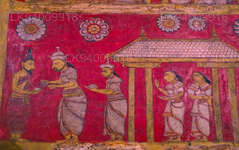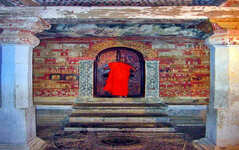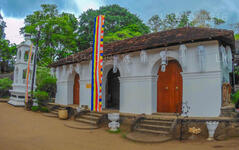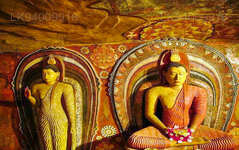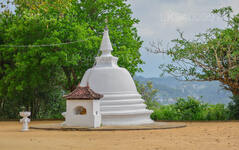
Город Канди
Канди, живописный город в центральной части Шри-Ланки, славится своим богатым культурным наследием, яркими фестивалями и живописной природой. Расположенный среди пышных холмов, Канди известен Храмом Зуба Будды, объектом Всемирного наследия ЮНЕСКО, и предлагает захватывающее сочетание истории и природного великолепия.
Degaldoruwa Raja Maha Vihara
Amongst the rocky slopes and green valleys of rural Kandy lies a hidden treasure; the Degaldoruwa Raja Maha Vihara. This temple awes those who view it with its incredible Kandyan era frescoes. Construction of the temple began in the late 1770s under the reign of King Kirti Sri Rajasinha and was completed under the reign of his brother Rajadhi Rajasinha years later.
Legend
According to folklore a farmer was exploring the area and found a crevice between two rocks. On venturing into space he found a cave with a pile of golden sickles. The farmer was delighted with his discovery but feared retribution from some strange power. So he simply took only one sickle every morning and, after using it in his fields, returned it in the evening. His fields yielded an extremely healthy harvest and the farmer attributed it to the golden sickle. But then he became greedy. After all, he had been taking the sickles every day and there had been no ill effects, and there was a whole pile of them. So on the very last day of the harvest, he took two sickles instead of one and did not return one of them.
But unknown to the farmer, there had indeed been a guardian for the treasure. The guardian noticed the farmer taking the sickles, but kept quiet as he always returned them. On the day that the farmer took one sickle for himself, the guardian saw it at once and confronted him in his home. The terrified farmer immediately rushed to the crevice and returned the golden sickle that he had stolen. The guardian, who had been disappointed, then sealed the crevice by fusing the two rocks together. However, the villagers got to know this story and informed the king, Kirti Sri Rajasinha; who then ordered that the cave be found and a temple erected in it.
The Structure
- The temple is hollowed out of a 40 foot rock outcrop extending a natural cave. It consists of an elegant rock shelter with two roofed antechambers in front; a drummers’ hall and an image house; and the main shrine room cut into the rock itself. The two antechambers are constructed outside the rock outcrop and have wooden roofs.
- The architecture is unusual for the period as the drummers’ hall is not usually attached to the main temple.
- The image house is located through a set of old wooden doors, situated under a carved wooden Dragon Arch. It preserves a moonstone and a sequence of elaborate and colorful paintings showing scenes from four Jātaka tales, which tell the stories of the previous lives of Buddha.
- The door of the shrine room is banded with metal and once had jewels embedded within it. The inner walls of the shrine are completely covered in paintings; including the door.
- In addition to this main structure, there is a bo tree and a stupa on a plateau on the summit of the rocky outcrop above the temple. They can be reached by stairs carved into the temple.
The Frescoes
The paintings of Degaldoruwa, which are supposed to be some of the best of the Kandyan era, are believed to be the work of four ‘Sittara’ artists. The finest of these paintings grace the ceiling of the temple; ‘Mara Yudde’, an artistic depiction of Buddha’s internal spiritual battle against Māra, the demon of death, rebirth, and desire.
The murals are unique in that all the elements; the people, the trees and the animals; are a uniform size and only the front views of ]people are shown. The trees have a stylized form, with their branches and leave spreading out to either side. The individual elements, such as the adornments on the elephants and the uniforms of the attendants, are portrayed in great detail. All of the colors used by the artists in the murals were created from the barks
О округе Канди
Район Канди расположен в центральной провинции Шри-Ланки. Один из семи объектов Всемирного наследия ЮНЕСКО в Шри-Ланке, Канди когда-то был домом королей Канди в 16 веке и источником всей музыки, искусств, ремесел и культуры в стране. Примерно в 129 км от Коломбо, Канди расположился среди холмистой местности, и все взгляды прикованы к центру города, где озеро Канди образует очаровательную особенность. Канди сохраняет большое религиозное значение для Шри-Ланки, потому что именно в этом очаровательном городе находится Далада Малигава или «Храм Зуба Будды», в котором хранится священная реликвия Зуб Будды. Королевский ботанический сад Перадения расположен примерно в 5 км к западу от центра города в Перадении и ежегодно его посещают 1,2 миллиона человек. Это самый большой ботанический сад на острове. Удаватта Келе (Лес Удаватта) — это охраняемый заповедник, расположенный в самом центре города, к северу от Храма Зуба Будды. Канди — город с преимущественно сингальским населением; здесь проживают значительные общины других этнических групп, таких как мавры и тамилы. По уровню экономики Шри-Ланки Канди уступает только Коломбо. Многие крупные корпорации имеют в Канди крупные филиалы, а многие отрасли промышленности включают текстильную, мебельную, IT и ювелирную. В городе расположено множество сельскохозяйственных исследовательских центров. Это кладезь музыки, искусств, ремёсел и культуры страны. Примерно в 129 км от Коломбо, Канди расположился среди холмистой местности, и все взгляды прикованы к центру города, где озеро Канди образует очаровательную достопримечательность. Канди сохраняет большое религиозное значение для Шри-Ланки, поскольку именно в этом очаровательном городе находится Далада Малигава или Храм Зуба Будды, в котором хранится священная реликвия Будды.
О Центральной провинции
Центральная провинция Шри-Ланки в основном состоит из горной местности. Площадь провинции составляет 5674 км², а население — 2421148 человек. Некоторые крупные города включают Канди, Гампола (24730), Нувара-Элия и Бандаравела. Население представляет собой смесь сингалов, тамилов и мавров. Как горная столица Канди, так и город Нувара-Элия расположены в Центральной провинции, как и Шри-Пада. Провинция производит большую часть знаменитого цейлонского чая, посаженного британцами в 1860-х годах после того, как опустошительная болезнь уничтожила все кофейные плантации в провинции. Центральная провинция привлекает множество туристов горными городами, такими как Канди, Гампола, Хаттон и Нувара-Элия. Храм Зуба Будды или Далада Малигава является главным священным местом в провинции Сентрал. Климат прохладный, и во многих районах на высоте около 1500 метров часто бывают прохладные ночи. Западные склоны очень влажные, местами выпадает почти 7000 мм осадков в год. Восточные склоны относятся к зоне средней сухости, поскольку дожди здесь приносят только северо-восточные муссоны. Температура воздуха колеблется от 24 °C в Канди до всего лишь 16 °C в Нувара-Элии, расположенной на высоте 1889 м над уровнем моря. Самые высокие горы Шри-Ланки находятся в Центральной провинции. Рельеф преимущественно гористый, с глубокими долинами. Два основных горных региона — Центральный массив и хребет Наклс к востоку от Канди.


